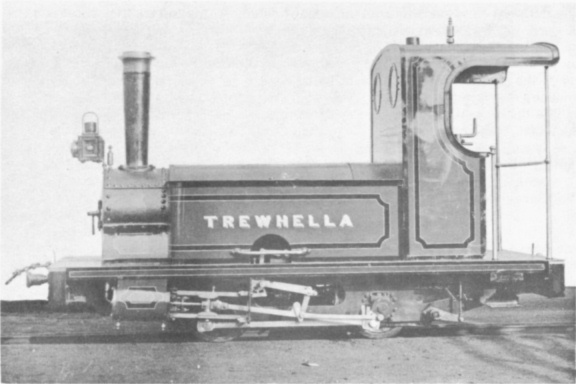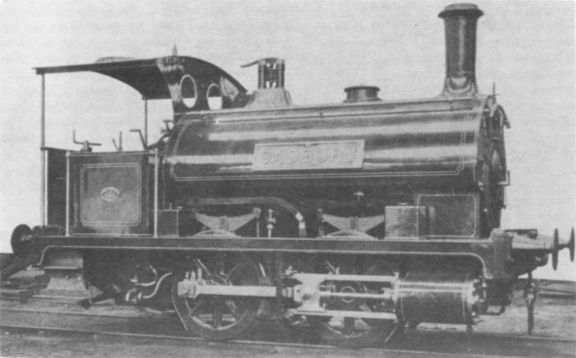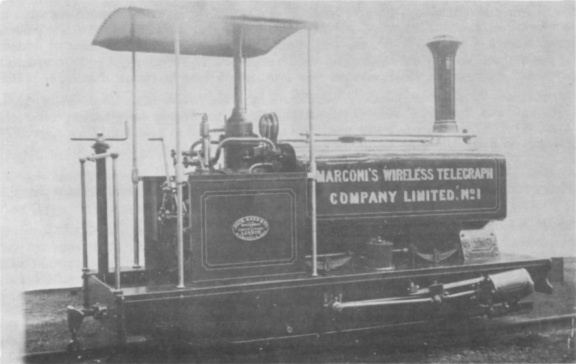
| THE INDUSTRIAL RAILWAY RECORD |
© DECEMBER 1969 |
PICTURE PARADE
DAN McDONALD
Many years ago I bought for a shilling or two an old album which contained a dozen unmounted photographs of locomotives built by Dick, Kerr & Co Ltd of Kilmarnock. These half-plate prints appear to have been slipped in the album pages by an amateur as there is no indication that the collection had been assembled officially. TREWHELLA (top), the only one of the twelve not to sport a worksplate, has a Cornish sounding name; its valve gear is interesting and I think it is Morton's Patent which Dick Kerr used on some of their narrow gauge designs. CADBURY (centre) is a neat little engine of orthodox design, except for what appears to be a lubricator over the smokebox door. My last picture shows a neat little 0‑4‑0 saddle tank (bottom) owned by Marconi's Wireless Telegraph Co Ltd which worked at the wireless station at Clifden in County Galway, connected to the nearest road over a mile away across the bog by a 2ft 0in gauge tramway. No.1 hauled the 9‑ton boilers to the power station and then kept them supplied with fuel, mainly turf. It was beside this line that Alcock and Brown landed after the first transatlantic flight in 1919. The wireless station was wrecked in 1922 during the Irish Civil War, and was not rebuilt. Useful equipment was brought back to Britain, and I understand that this included the locomotive. The print of CADBURY bears the pencilled number 547 on the back, and that of the Marconi engine 621. These may be merely the numbers of the negatives but I mention them as a matter of interest.



(This contribution by Mr McDonald was of more than usual interest to us as we recalled having seen a photograph of TREWHELLA previously. But where? Then the mystery was solved on our next visit to the Hunslet Engine Company at Leeds, for there in an old Kerr Stuart album appears the self-same picture. Not all that surprising we suppose as before 1893 Kerr Stuart were agents rather than builders, and TREWHELLA is obviously one of the engines which passed through their hands. Whilst it may have gone to Cornwall we think it more probable that TREWHELLA had some connection with Robert Trewhella, a railway contractor, who is understood to have been in business as early as 1871 although full details of his contracts are not known. However, he did build the 3ft 13/8in gauge line from Palermo to Corleone for the Sicilian Railway Company of which he was one of the principal shareholders. During the 1880's he owned sulphur mines at Sant'Augostino in central Sicily which were connected with Raddusa station on the Catania to Palermo line by an 850mm gauge railway, 9.2km in length. It was opened with mule traction on 1st August 1885, but in the following year Hawthorn Leslie supplied three tank locomotives. Mr P.M. Kalla-Bishop, to whom we are indebted for the information on Robert Trewhella, says that the mines and railway closed about 1900. If TREWHELLA did work at the Sant'Augostino mines, it would have been built presumably no later than the mid‑1890's. Unfortunately, the album print of TREWHELLA gives no clue for it is one of three which have no pencilled (? negative) number on the reverse; the others range from 1901 (number 499) to 1905 (number 621).
Unless the negative providing Mr McDonald's print of TREWHELLA was very skilfully "doctored" there is no sign of a worksplate having been affixed to the cabside. As can be seen, however, CADBURY and the Marconi engine do carry worksplates, these showing the year (of construction?) but no works number. The detail on CADBURY'S plate is somewhat indistinct (although the year is 1904), but on No.1 it reads "DICK, KERR & CO. LIMITED / ENGINEERS AND CONTRACTORS / LONDON AND KILMARNOCK 1905". Further details of the Marconi locomotive and railway can be found in the issue of The Locomotive Magazine dated 15th February 1909, and also in Walter McGrath's Some Industrial Railways of Ireland, published by the author in 1959. A minor point of interest is that the date of No.1 in the Union Publications booklet, Irish Industrial and Contractors' Locomotives, is given as 1906 whereas the photograph clearly shows this to be 1905.
The Society's records for Cadbury Brothers Ltd., Bournville, near Birmingham, show their Nos.1, 2 and 3 as Dick, Kerr 0‑4‑0 saddle tanks, and there is every reason to believe that the CADBURY we illustrate was one of them. No.3 is said to have been Dick Kerr 9976 of 1901, but on what authority we do not know. - Hon. Eds.)
*************************************************************************
"On Wednesday last [1st August 1849] the Monmouthshire Railway and Canal Company became exclusive carriers on their tram roads in the Western Vallies [sic] and between Snatchwood and Blaenavon Ironworks. Locomotive built by Neath Abbey Iron Company started from Newport at 7.50 a.m., and reached Blaina Chureh at 2 p.m. Simultaneously another locomotive built by Stothert, Slaughter and Co., left for Victoria Iron Works, reaching there by 2 p.m. - several derailments. Up to the present the companies' locomotives (15" cylinders and 19 tons) have not accomplished the speed or loads of the locomotives of the ironmasters, now superseded, latter being 10½" cylinders, 13 tons. (Mining Journal, 4th August 1849. - ALFF)